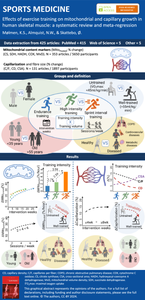Sports Medicine ( IF 9.3 ) Pub Date : 2024-10-10 , DOI: 10.1007/s40279-024-02120-2
Knut Sindre Mølmen 1 , Nicki Winfield Almquist 2 , Øyvind Skattebo 3

|
Background
Skeletal muscle mitochondria and capillaries are crucial for aerobic fitness, and suppressed levels are associated with chronic and age-related diseases. Currently, evidence-based exercise training recommendations to enhance these characteristics are limited. It is essential to explore how factors, such as fitness level, age, sex, and disease affect mitochondrial and capillary adaptations to different exercise stimuli.
Objectives
The main aim of this study was to compare the effects of low- or moderate intensity continuous endurance training (ET), high-intensity interval or continuous training (HIT), and sprint interval training (SIT) on changes in skeletal muscle mitochondrial content and capillarization. Secondarily, the effects on maximal oxygen consumption (VO2max), muscle fiber cross-sectional area, and fiber type proportion were investigated.
Methods
A systematic literature search was conducted in PubMed, Web of Science, and SPORTDiscus databases, with no data restrictions, up to 2 February 2022. Exercise training intervention studies of ET, HIT, and SIT were included if they had baseline and follow-up measures of at least one marker of mitochondrial content or capillarization. In total, data from 5973 participants in 353 and 131 research articles were included for the mitochondrial and capillary quantitative synthesis of this review, respectively. Additionally, measures of VO2max, muscle fiber cross-sectional area, and fiber type proportion were extracted from these studies.
Results
After adjusting for relevant covariates, such as training frequency, number of intervention weeks, and initial fitness level, percentage increases in mitochondrial content in response to exercise training increased to a similar extent with ET (23 ± 5%), HIT (27 ± 5%), and SIT (27 ± 7%) (P > 0.138), and were not influenced by age, sex, menopause, disease, or the amount of muscle mass engaged. Higher training frequencies (6 > 4 > 2 sessions/week) were associated with larger increases in mitochondrial content. Per total hour of exercise, SIT was ~ 2.3 times more efficient in increasing mitochondrial content than HIT and ~ 3.9 times more efficient than ET, while HIT was ~ 1.7 times more efficient than ET. Capillaries per fiber increased similarly with ET (15 ± 3%), HIT (13 ± 4%) and SIT (10 ± 11%) (P = 0.556) after adjustments for number of intervention weeks and initial fitness level. Capillaries per mm2 only increased after ET (13 ± 3%) and HIT (7 ± 4%), with increases being larger after ET compared with HIT and SIT (P < 0.05). This difference coincided with increases in fiber cross-sectional area after ET (6.5 ± 3.5%), HIT (8.9 ± 4.9%), and SIT (11.9 ± 15.1%). Gains in capillarization occurred primarily in the early stages of training (< 4 weeks) and were only observed in untrained to moderately trained participants. The proportion of type I muscle fibers remained unaltered by exercise training (P > 0.116), but ET and SIT exhibited opposing effects (P = 0.041). VO2max increased similarly with ET, HIT, and SIT, although HIT showed a tendency for greater improvement compared with both ET and SIT (P = 0.082), while SIT displayed the largest increase per hour of exercise. Higher training frequencies (6 > 4 > 2 sessions/week) were associated with larger increases in VO2max. Women displayed greater percentage gains in VO2max compared with men (P = 0.008). Generally, lower initial fitness levels were associated with greater percentage improvements in mitochondrial content, capillarization, and VO2max. SIT was particularly effective in improving mitochondrial content and VO2max in the early stages of training, while ET and HIT showed slower but steady improvements over a greater number of training weeks.
Conclusions
The magnitude of change in mitochondrial content, capillarization, and VO2max to exercise training is largely determined by the initial fitness level, with greater changes observed in individuals with lower initial fitness. The ability to adapt to exercise training is maintained throughout life, irrespective of sex and presence of disease. While training load (volume × intensity) is a suitable predictor of changes in mitochondrial content and VO2max, this relationship is less clear for capillary adaptations.
Graphical Abstract
中文翻译:

运动训练对人骨骼肌线粒体和毛细血管生长的影响:系统评价和元回归
背景
骨骼肌线粒体和毛细血管对有氧适能至关重要,而抑制水平与慢性和年龄相关疾病有关。目前,增强这些特征的循证运动训练建议有限。必须探索健康水平、年龄、性别和疾病等因素如何影响线粒体和毛细血管对不同运动刺激的适应。
目标
本研究的主要目的是比较低或中等强度连续耐力训练 (ET) 、高强度间歇或连续训练 (HIT) 和冲刺间歇训练 (SIT) 对骨骼肌线粒体含量和毛细血管化变化的影响。其次,研究了对最大耗氧量 (VO2max) 、肌纤维横截面积和纤维类型比例的影响。
方法
在 PubMed、Web of Science 和 SPORTDiscus 数据库中进行了系统文献检索,没有数据限制,截至 2022 年 2 月 2 日。如果 ET 、 HIT 和 SIT 的运动训练干预研究具有至少一种线粒体内容或毛细血管化标志物的基线和随访测量,则纳入这些研究。总共包括 353 篇和 131 篇研究文章中 5973 名参与者的数据,分别用于本综述的线粒体和毛细血管定量合成。此外,从这些研究中提取了 VO2max 、 肌纤维横截面积 和 纤维类型比例的测量值。
结果
在调整了相关协变量(例如训练频率、干预周数和初始健康水平)后,响应运动训练的线粒体含量增加百分比与 ET (23 ± 5%) 、HIT (27 ± 5%) 和 SIT (27 ± 7%) 相似 (P > 0.138),并且不受年龄、性别、更年期、疾病或参与的肌肉质量的影响。较高的训练频率 (6 > 4 > 2 次/周) 与线粒体含量的较大增加相关。每总运动小时,SIT 在增加线粒体含量方面的效率是 HIT 的 ~ 2.3 倍,是 ET 的 ~ 3.9 倍,而 HIT 的效率是 ET 的 ~ 1.7 倍。在调整干预周数和初始健康水平后,每纤维毛细血管的增加与 ET (15 ± 3%) 、HIT (13 ± 4%) 和 SIT (10 ± 11%) (P = 0.556) 相似。每 mm2 的毛细血管仅在 ET (13 ± 3%) 和 HIT (7 ± 4%) 后增加,与 HIT 和 SIT 相比,ET 后增加幅度更大 (P < 0.05)。这一差异与 ET (6.5 ± 3.5%) 、HIT (8.9 ± 4.9%) 和 SIT (11.9 ± 15.1%) 后纤维横截面积的增加相吻合。毛细血管化的增加主要发生在训练的早期阶段 (< 4 周),并且仅在未训练至中等训练的参与者中观察到。运动训练使 I 型肌纤维的比例没有改变 (P > 0.116),但 ET 和 SIT 表现出相反的效果 (P = 0.041)。五O2max 与 ET、HIT 和 SIT 的增加相似,尽管与 ET 和 SIT 相比,HIT 显示出更大的改善趋势 (P = 0.082),而 SIT 显示每小时运动增加幅度最大。较高的训练频率 (6 > 4 > 2 次/周) 与 VO2max 的较大增加相关。与男性相比,女性在 VO2max 中表现出更大的百分比增加 (P = 0.008)。一般来说,较低的初始适应水平与线粒体含量、毛细血管化和 VO2max 的较大百分比改善相关。SIT 在训练早期阶段对改善线粒体含量和 VO2max 特别有效,而 ET 和 HIT 在更多的训练周内表现出缓慢但稳定的改善。
结论
运动训练中线粒体含量、毛细血管化和 VO2max 的变化幅度在很大程度上取决于初始健康水平,在初始健康水平较低的个体中观察到的变化更大。适应运动训练的能力终生保持,无论性别和是否存在疾病。虽然训练负荷 (体积×强度) 是线粒体含量和 VO2max 变化的合适预测因子,但这种关系对于毛细血管适应不太清楚。

































 京公网安备 11010802027423号
京公网安备 11010802027423号